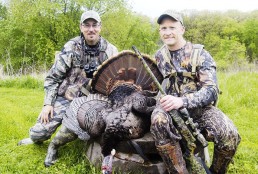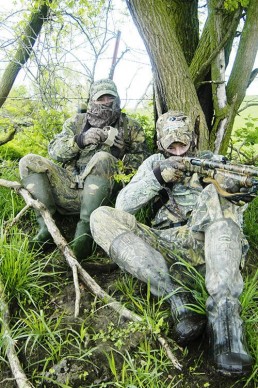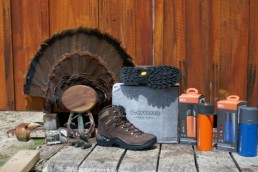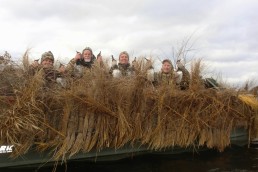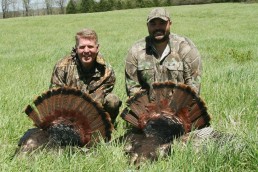Best Practices for Hunting Tough Turkeys
SHARE THIS POST
If you’ve been part of the corporate world the past few years, you’ve no doubt heard the term “best practices.” And like many folks, you’ve probably asked, “What the heck does that mean?”
A brief Google search turned up these somewhat confounding definitions:
1) Standard operating methods found to produce the best performance and results in a given industry or organization.
2) The processes, practices and symptoms… that performed exceptionally well and are widely recognized.
3) Planning and/or operational practices that have proven successful in particular circumstances.
For our purposes, let’s stick with this translation: Best practices are methods or systems that work. In turkey hunting terms, those practices include the skills, knowledge, experience and mindset that help you consistently fill tags, no matter what the circumstances. These are the elements that define you as a turkey hunter. They let you kill turkeys when other folks don’t—in wind, rain, heat and other seemingly impossible situations.
Turkey hunters acquire and hone their best practices one way: experience afield. Because much of my professional life has involved writing about turkey hunting, I feel weird saying this, but here goes: Reading and hearing about successful strategies can help you in your turkey pursuits, but until you actually do something, you won’t truly learn about it. Experience is by far the best teacher. To learn, you must do.
Experience tells you what to expect and how to react. It makes decisions easier and helps you decrease—though not avoid—mistakes. It also helps calm your pounding chest, still your shaking hands and focus on the hunt when opportunity presents itself.
School is in session every day in the turkey woods. From the minute you leave your truck until the second legal shooting hours expire, the birds and their environment are revealing tiny, subtle clues. As hunters, we have to pay attention and decipher those daily tutorials. Sometimes, learning comes easily, like when you stop calling to a hung-up gobbler and he walks into range 20 minutes later. Often, the lessons are harsh, as when you take one step too many in open woods and send turkeys scattering to the four winds. And many times, you don’t even decipher the lessons until days or even years later.
Always pay attention to details and try to learn the small stuff. Work endlessly at refining your skills, whether it’s calling, shooting, identifying sign or moving through the woods. When you make observations, ask yourself, “Why?” Try to apply your conclusions to other situations. Above all, keep an open mind, and don’t make hasty judgments or determinations. Let turkeys teach you, and apply those lessons every day.
The bird and its landscape
First and foremost, learn everything you can about turkeys: their vocabulary, habits, tendencies, physical characteristics, behavior patterns and eccentricities, and their reaction to weather, calling and other factors. Discover how the social interaction between turkeys changes through the spring breeding season. Scout like a madman.
You could write volumes about each of those topics, but there are some general rules.
You’ve probably heard folks discuss the differences between Easterns, Merriam’s, Rio Grandes and Osceolas, but really, turkeys are turkeys, no matter where they live. Honestly, the differences boil down to this: hunting pressure and how turkeys use the landscape in a specific area.
The former is easy to define. If you take your average gobbler and plop him down in the middle of a public hunting area in Pennsylvania or New York, he’ll likely be bumped, boogered and spooked numerous times throughout his life — and possibly shot at. If you take the same turkey and raise him in the South Dakota prairie, he will face far less interaction with bumbling human predators. Which turkey will be easier to hunt? It’s a simple answer.
The landscape factor is tougher to crack, but it’s a critical piece of the puzzle. The basics are widely known, but the specifics of how turkeys use the land varies greatly by region. Remember the turkey in Pennsylvania versus the one in South Dakota? The Eastern bird might spend most of his time on a hardwood ridge, follow hens into a wooded hollow, strut in a hilltop meadow and never travel more than a few hundred yards all day. The prairie bird might sail down and make a beeline for the nearest food source, which could be a mile or more away. At night, he’ll make the trip back, because the big cottonwoods he favors are the only viable roost trees in the area.
The bottom line is this: No matter where you hunt, you must spend time with turkeys to learn about their peculiarities. Scout, hunt or just watch. Each opportunity to learn more about the bird will pay big dividends later.
The skilled turkey hunter
Successful turkey hunters have several common attributes: They’re excellent woodsmen, they can call, and they are skilled with the tools needed to get the job done.
Are you enjoying this post?
You can be among the first to get the latest info on where to go, what to use and how to use it!
Being a woodsman, of course, is predicated on spending lots of time in the woods and having that aforementioned experience with and knowledge of turkeys. Good woodsmen find and identify turkey sign, such as tracks, feathers droppings, scratching and dust bowls. They constantly listen to and watch turkeys. Using those observations and the clues provided by the sign they’ve found, they can put together pieces of the puzzle and formulate solid game plans.
Good woodsmen are quiet and stealthy. They can slip through the timber, making light footfalls on the crunchy forest floor and avoiding other noise, all the while watching and listening for turkeys or other critters. They can walk along a ridge without being sky-lighted or slip along a field edge without sticking out like a sore thumb. Depending on a turkey’s location, they know when to move and when to stay absolutely still. If necessary, they can slip and crawl on the ground to relocate or gain ground on a bird. They’re constantly filtering through the din of sounds in the spring woods, listening for distant gobbles or yelping. When they hear it, they can course it correctly and determine pretty much where a turkey is located.
Along with experience, “woodsmanship” is the most important factor in turkey hunting success. I’ve often said that if you pit a good woodsman and poor caller against a great caller but shoddy woodsman, the former will kill turkeys more consistently than the latter.
If you combine good woodsmanship with solid calling, you’ll be a gobbler-hunting machine. When I say “solid calling,” I don’t mean that you have to be a contest-caliber yelper. However, you must sound as realistic as possible, be well-versed with all types of calls, be able to produce a variety of turkey vocalizations and, above all, be confident and smart with your calling.
Don’t fall in love with your calling. Remember, it’s one leg in a solid foundation of turkey hunting success. If you just want to marvel at your calling prowess, have your buddies over to your house, and hammer away on your favorite box, slate or diaphragm. If you’re interested in turkey hunting, remember that the wonderful noises you make are just intended to make a gobbler believe there’s a hen there. Learn when to call and when to shut up, and know which calls to use in specific situations.
Also, make sure your equipment is ready for any turkey task. Be familiar with your shotgun, choke and load combination, and know their effective range. Make sure your camo (hat, facemask, gloves, shirt, pants and boots) isn’t too faded, and that your clothing will keep you warm during chilly mornings, yet comfortable when the midday heat sets in. Keep your calls in good working order. If you’re hunting big country, a compass or Global Positioning System unit will help. Good binoculars are pretty much mandatory anywhere except the thickest timber. And whether you use them or not, it’s always wise to have two or three good-looking turkey decoys in your vest.
More than anything, know how to use your equipment, and make sure you can access it when you need it. If you do so, you might just need two more pieces of gear: your turkey tote and a sharp knife.
The persistent mindset
More than any other outdoor activity, turkey hunting requires persistence and a positive attitude. The roller coaster that is spring hunting can change in a second, turning a seemingly wasted day or week into the hunt of a lifetime.
That’s because of the nature of turkeys. As mentioned, they often act in seemingly random fashion, not following any pattern or mode of behavior from day to day. In the blink of an eye, a gobbler that has acted disinterested all week can suddenly get hot, gobble at your calling and run in. That’s why old-timers say that with turkey hunting, “Every day is opening day.” It’s corny but absolutely true.
Never give up on a turkey hunt. Sure, you might have to give up on some gobblers—those that walk away, clam up or seemingly disappear—but keep hunting as long as you can. You never know when a hen will leave a gobbler, or you’ll strike just the right note that gets a longbeard to fire up or reveal his location, setting the wheel of opportunity in motion.
A never-say-die-attitude won’t net you a gobbler every day or even every spring, but it will put more than a few beards and spurs on your wall. That was never more evident than almost 15 years ago, when I was finishing up what seemed like a fruitless week hunting in southern Wisconsin.
The final morning of my hunt, I worked a tepid gobbler for about 20 minutes before he drifted away with a hen. In desperation mode, I spent the rest of the morning driving through a large public area, yelping and cutting into the timber in hopes of striking a hot bird. I received no responses. Finally, willing to accept my failure, I returned to my original setup at 11:45 a.m., for one last shot. I had to leave at noon, so it was really a futile gesture. My yelping series netted nothing, so I walked to the edge of the timber and prepared to say goodbye to my hunting grounds. Just then, a crow flew over a nearby pine grove and caw-cawed loudly. A thunderous gobble echoed in response. The bird I’d worked that morning was loafing in the shade of the trees.
I slipped into the area, made a quick series of calls and was walking out two minutes later with the longbeard slung over my shoulder. It was 12:01 p.m., and I’d killed the gobbler at the last possible minute of my hunt.
Will that ever happen again? I don’t know. However, the memory of that hunt will keep me in the woods every day until the closing bell sounds.
Editor’s note: This is an excerpt from Brian Lovett’s latest book, “Hunting Tough Turkeys.” Signed copies are available for by contacting the author at brianlovett131@gmail.com.
MWO
SHARE THIS POST
Did you enjoy this post?
You can be among the first to get the latest info on where to go, what to use and how to use it!
MWO
We believe being outdoors is good. With more than 1,000 articles each year, MidWest Outdoors magazine is all about sharing outdoor experiences with you—where to go, what to use and how to use it… whether you’re close to home or on that trip of a lifetime.
